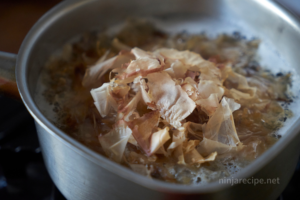Dashi (Japanese soup stock) is an essential part of the Japanese food culture. It is frequently used in miso soup, hot-pot dishes (Nabe 鍋), and a variety of other dishes. There are about eight major types of dashi in Japan, and the one made from bonito and kelp (Awase Dashi 合わせだし) is the basic of them all. You’ll find many of my recipes using these dashi broth. This recipe is the one you should definitely keep in mind!
Making dashi is the foundation of Japanese food and it is a very first step to making “delicious Japanese food at home“. It takes some time and effort, but you’ll be surprised at how much better your food tastes, and as long as you have dashi, you’ll be able to prepare your food efficiently!
Information
| PREP TIME: 30 mins | COOK TIME: 20 mins | TOTAL TIME: 50 mins |
| COURSE: Soup | CUISINE: Japanese | SERVINGS: 1 liter |
Ingredients
- 1 liter water
- 10 g dried bonito flakes – katsuobushi
- 10 g kelp – kombu
Instructions
- Soak Kombu in a water for more than 30 minutes before putting it on heat in order to bring out the umami from it.
- Set the heat a little higher than low and cook slowly for about 10 minutes until just before boiling.
- Take out the kombu, and bring it to a boil and then turn off the heat.
- With the heat turned off, add the bonito flakes and bring the pot to a boil again over medium to high heat. As soon as it comes to a boil, reduce the heat and scoop out the scum with a ladle.

- Simmer slowly for 4 minutes over low heat to bring out the flavor.
- Turn off the heat and strain through a tea strainer or a fine colander lined with a layer of kitchen paper. Do not squeeze, but wait for it to be filtered out automatically.
- When the heat is removed, store in the refrigerator (it is better to use it up in the refrigerator in two or three days).
Notes
Kombu is a dried food, so if you put it in a water and boil it immediately, the umami can’t be brought out well. Therefore, make sure to put it on the fire after the hard kombu returns to a large size. (You can put the kombu in the water an hour ahead of time or even the day before. ) Keep it in the refrigerators when it’s hot.
Be careful not to boil with kombu in it because you will get strong kombu smell!!









